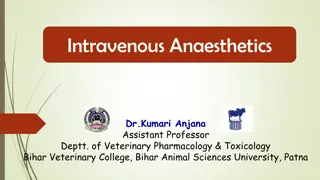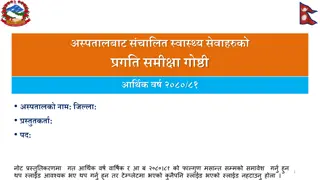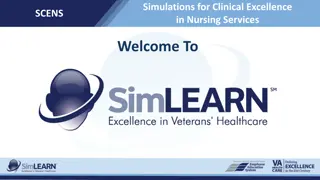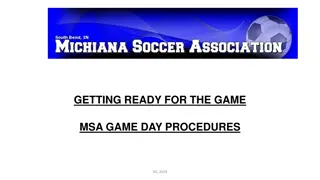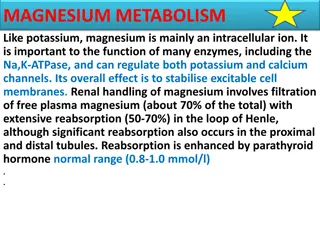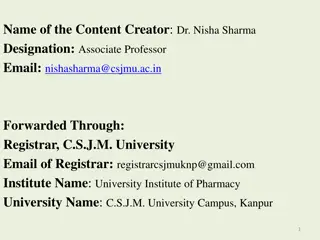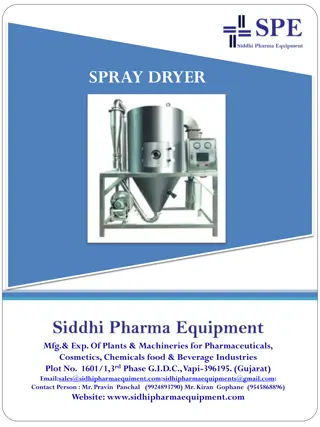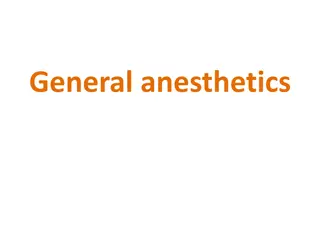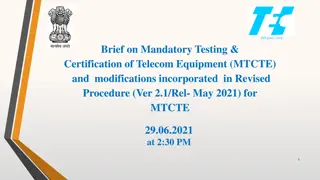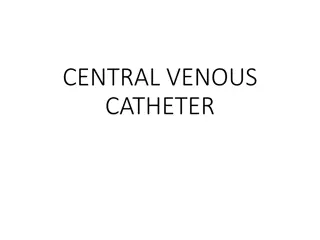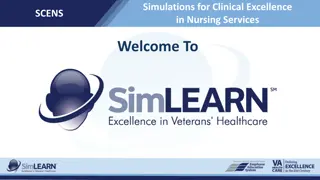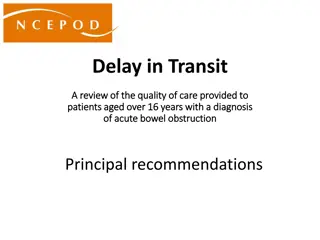Understanding Equipment and Techniques in Intravenous Preparation
Explore the role and function of equipment like syringes, needles, IV sets, catheters, etc., in IV preparation. Learn about IV solution characteristics, aseptic technique in pharmacy, handling hazardous drugs, and quality assurance programs in hospitals. Discover the importance of aseptic technique in sterile compounding and compliance with USP standards.
Download Presentation

Please find below an Image/Link to download the presentation.
The content on the website is provided AS IS for your information and personal use only. It may not be sold, licensed, or shared on other websites without obtaining consent from the author. Download presentation by click this link. If you encounter any issues during the download, it is possible that the publisher has removed the file from their server.
E N D
Presentation Transcript
Chapter 11 Created by Jennifer Majeske, Mineral Area College
Identify the role and function of equipment used in intravenous preparation and administration, including syringes, needles, intravenous sets, catheters, infusion pumps, and filters. Identify the components of an intravenous administration set. Describe common characteristics of intravenous solutions, including pH value, osmolarity and osmolality, tonicity, compatibility, and stability. Created by Jennifer Majeske, Mineral Area College
Summarize the steps necessary for aseptic technique in a hospital pharmacy. Describe the correct procedure used in preparing compounded sterile preparations from vials and ampules for hazardous and nonhazardous agents. Discuss the preparation of total parenteral nutrition. Differentiate between expiration dating and beyond-use dating. Created by Jennifer Majeske, Mineral Area College
Understand the types of premade parenteral products, including vial-and-bag systems and frozen intravenous solutions, and their handling requirements. Calculate intravenous flow rate. Discuss the importance of and techniques for preparing, handling, and disposing of hazardous agents. Define the purpose and list examples of quality assurance programs in the hospital. Created by Jennifer Majeske, Mineral Area College
Hospitals carry out unique activities, such as the preparation, handling, and disposing of hazardous drugs. A major responsibility of the pharmacy tech involves compounded sterile products (CSPs). Aseptic technique the processes and physical preparation methods used by sterile compounding personnel to avoid introducing pathogens, into parenteral products. Compliance with sterile compounding and aseptic technique standards established by USP. Reflected in Chapter <797> standards. Created by Jennifer Majeske, Mineral Area College
Syringes and Needles: used for withdrawing or injecting solutions during the preparation of CSPs. IV push (IVP) bolus administration; rapid injection of a medication. Syringes: made of glass or plastic; glass limited use, expensive; plastic less expensive, supplied in sterile packaging, disposable. Created by Jennifer Majeske, Mineral Area College
Main components: Syringe tip Barrel contains calibration marks Rubber-tipped piston plunger Created by Jennifer Majeske, Mineral Area College
Technicians should choose the smallest syringe that is able to hold the desired volume; at least full. Technicians should count the number of marks between labeled measurement units, to get the most accurate dose. The volume of solution is measured at the point of contact between the rubber-tipped piston plunger and the inside of the barrel. Created by Jennifer Majeske, Mineral Area College
Needles are made of stainless steel or aluminum. Needle size is determined by length and gauge. Lengths range from 3/8 inch to 6 inches. Gauge refers to the diameter of the opening; the larger the gauge number the smaller the opening (or size of the lumen). 31-gauge (smallest bore) 13-gauge (largest bore) Created by Jennifer Majeske, Mineral Area College
Parts of a Needle: Needle tip Bevel Heel Needle shaft Needle lumen Needle hub Handling of the Needle-and-Syringe Unit: A syringe comes from the manufacturer in sterile packaging. Sterile compounding personnel must not touch the sterile parts or critical sites of the syringe or needle. Created by Jennifer Majeske, Mineral Area College
Critical site the part of the supply item that includes any fluid- pathway surface or opening that is at risk for contamination by touch or airflow interruption. Created by Jennifer Majeske, Mineral Area College
IV administration set a sterile, disposable device used to deliver IV fluids and injectable medications directly into a patient s vein. IV sets do not have expiration dates, but do contain Federal law restricts this device to sale by or on the order of a physician. An IV infusion pump is nondisposable, reusable equipment often referred to as durable equipment. Created by Jennifer Majeske, Mineral Area College
Universal spike adaptor (tubing spike or spike) Pierces the rubber stopper or port of the IV Drip chamber Allows healthcare personnel to view and count drops of IV fluid Roll clamp Adjust flow rate Flexible tubing Delivers the fluid Needle adaptor Attaches a needle or catheter to the patient Created by Jennifer Majeske, Mineral Area College
Universal Spike Adaptor: spike used to pierce the IV s tubing port; some IV sets have an air vent. Drip chamber hollow drip chamber; allows any air bubbles to rise to the top of the IV fluid. Drop set number of drops it takes to make 1 mL; also know as the tubing s drop factor. Macrodrip set: 10, 15, 20 gtts/mL Microdrip or minidrip set: 60 gtts/mL Created by Jennifer Majeske, Mineral Area College
Roll Clamp a hard, plastic clip that contains a smaller roller allowing control of the flow of fluid. Flexible tubing IV tubing, molded from pliable PVC and other plasticizers. Needle adaptor usually located at the distal end of the IV set, close to the patient. Additional Components of an IV set: Y-site injection port allows medication to be added to the IV solution In-line filter provides protection against particulates Created by Jennifer Majeske, Mineral Area College
Length of IV sets vary, ranging from 6 to 120 inches. What determines length of IV tubing? Priming the action of flushing out the small particles in the tubing s interior lumen before medication administration. The amount of fluid needed to prime the tubing depends on the length of the set 3 to 15 mL. In-line filters has reduced the need for flushing the line with IV fluid before administration. Created by Jennifer Majeske, Mineral Area College
Nurses typically administer IV solutions to patients by attaching the IV tubing to the fluid container, establishing flow rate, and managing overall regulation. Catheter tube, implanted in the patient and affixed to the patient s skin. IV sets are changed every 24 96 hours to minimize the risk of infection. Created by Jennifer Majeske, Mineral Area College
Changes in the scope of pharmacy practice make it necessary for pharmacy personnel to have a complete understanding of IV sets and their operations. Pharmacist may: Select IV sets Serve on CPR or code teams Provide in-service training Use IV sets when transferring fluids Prime IV sets Created by Jennifer Majeske, Mineral Area College
Filter a device used to remove contaminants such as glass, fibers, and tiny bits of rubber that may have inadvertently entered the CSP during sterile compounding. Depending on size, filtration should protect the patient. Filters do not remove virus particles or toxins. Common filter sizes: 0.5 micron: random path membrane 0.45 micron: in-line filter 0.22 micron: removes bacteria to produce a sterile solution Created by Jennifer Majeske, Mineral Area College
Most IV preparations are comprised of ingredients added to a sterile water medium or base solution. Certain chemical properties or characteristics are needed of these preparations so damage does not occur to the patients blood cells or vessels or alters the chemical properties of blood. CSPs must possess chemical characteristics similar to blood serum. Created by Jennifer Majeske, Mineral Area College
Beyond-use date the date and time after which a CSP is no longer sterile, stable, or effective. pH Value the degree of acidity or alkalinity of a solution. Less than 7.0 = acidic Greater than 7.0 = basic (alkaline) Blood plasma pH 7.4 IV solutions should have a pH that is neutral (near 7.0) so they don t adversely affect the pH of the blood. Created by Jennifer Majeske, Mineral Area College
Osmolarity a measure of the number of milliosmoles of solute per liter of solution (mOsm/L). Blood plasma = 285 mOsm/L Osmotic pressure the pressure required to maintain equilibrium, with no net movement of solution across body membranes. Osmolality a measure of the number of milliosmoles of solute per kilogram of solvent. An IV preparation must be isoosmotic, meaning the solution should have the same number of particles in solution per unit volume and the same osmotic pressure as blood. Created by Jennifer Majeske, Mineral Area College
Hypotonic solution hypoosmolar solution; fewer number of dissolved particles than blood cells; water is drawn into cells, causing cells to swell. 0.45% normal saline (NS) Hypertonic solution hyperosmolar solution; greater number of dissolved particles than blood cells; water is drawn out of cells, causing cells to shrivel. 50% dextrose or 3% sodium chloride Isotonic solution similar number of dissolve particles as blood. 0.9% NS Created by Jennifer Majeske, Mineral Area College
Compatibility the ability to combine two or more base components or additives within a solution, without resulting in changes to the physical or chemical properties of the additives. Stability: is affected by storage conditions; some IV medications need to be refrigerated or frozen after compounding; amber-colored bags protect the drug from exposure to light. Created by Jennifer Majeske, Mineral Area College
Multiple IV solutions are available. Most common used IV infusions are dextrose in water, normal saline, or dextrose in saline. Table 11.1 pg. 444 Commonly Used IV Products and Abbreviations Technicians typically compound two types of CSPs: Large-volume parenterals Primary source of hydration Small-volume parenterals piggybacked Created by Jennifer Majeske, Mineral Area College
Large-volume parenteral (LVP) is used to replenish fluids and to provide drugs, electrolytes, and nutrients such as vitamins, minerals, and glucose. LVPs commonly available: 250 mL, 500 mL, and 1000 mL Potassium chloride is the most common additive. Lactated Ringer s Solution IV solution that contains a specific mixture of electrolytes. Created by Jennifer Majeske, Mineral Area College
Small-volume parenteral (SVP) a CSP that is dispensed in a minibag; over a short time period 10 minutes to an hour. SVPs commonly available: 25 mL, 50 mL, 100 mL, 150 mL, or 250 mL IV piggybacks (IVPBs) majority of SVPs prepared; small volume (50 to 100 mL) of a base solution (D5W) and a medication. Special SVP solutions include frozen IV solutions, premade IVPBs, and vial-and-bag systems. Created by Jennifer Majeske, Mineral Area College
A CSP label should contain the following: Patient s name and id # Room number Medication name and dose Base solution and amount Infusion period Flow rate Beyond-use date Signature or initials Additional information Created by Jennifer Majeske, Mineral Area College
Sterile preparations of IV medications by pharmacy personnel include single- and multi-dose vials, ampules, and other containers that must be transferred to an LVP or SVP. CSPs must be prepared in an ISO Class 5 laminar airflow hood. Table 11.2 pg. 447 Summary of Procedures to Maintain Aseptic Technique During Sterile Compounding Created by Jennifer Majeske, Mineral Area College
Vials a sealed, sterile, plastic or glass container that has a hard plastic cap; sizes range from 1 mL to 250 mL. Types of vials: Single-dose vials (SDV) do not contain a preservative one-time use used within 1 hour or discarded Multi-dose vials (MDV) do contain a preservative stable for 28 days Created by Jennifer Majeske, Mineral Area College
First disinfect the rubber stopper with 70% isopropyl alcohol. Pierce the rubber top with a needle-and- syringe unit. Bevel up; penetrate at an angle; straightened to 90 degrees. Coring the inadvertent introduction of a small piece of rubber top into the solution. A milking technique must be used to release negative pressure within the vial. Created by Jennifer Majeske, Mineral Area College
Some medications come freeze-dried (lyophilized), and need to be reconstituted with a diluent such as sterile water or NS before being injected into the IV. Vented needle allows the diluent to be injected into the vial while simultaneously venting the positive pressure that has built up within the vial. Created by Jennifer Majeske, Mineral Area College
The technician should arrange the vial, filled syringe, and the IV or IVPB base for a pharmacists final check. The pharmacist then verifies the technicians work. After verification the technician can proceed with preparing the CSP; checking for leaks and signs of incompatibility and labels the CSP for delivery. Created by Jennifer Majeske, Mineral Area College
Ampule a small, hermetically sealed container that has a distinct, elongated neck. Contains no preservative Some drugs are only available in an ampule because of incompatibility with rubber or PVC components of vials Parts of an Ampule: head, neck, shoulder, and body. Break ring a scored area on the neck that marks the site where a technician will break the glass to access the ampule s contents. Created by Jennifer Majeske, Mineral Area College
Opening an Ampule: safe opening of an ampule can be done with a piece of gauze, sterile 70% IPA swab or a ampule breaker a small plastic cap, placed over the head of an ampule. Hold the ampule upright, clear the medication from the head and neck. Clean the neck of the ampule. Hold the ampule in the non-dominant hand, grasping the head of the ampule with the dominant hand. Exert firm but gentle pressure on the break ring to snap the ampule s neck. Created by Jennifer Majeske, Mineral Area College
Withdrawing Medication from an Ampule: hold the ampule upright; bevel down in the corner near the opening. When the ampule is nearly empty, tilt the ampule slightly to allow easier access to the remainder of the medication. A filter needle should be used when drawing medication out of an ampule to avoid glass fragments. Created by Jennifer Majeske, Mineral Area College
Preparing a CSP with an Ampules Contents: similar to the process of preparation for a vial so that it can be checked by the pharmacist. The pharmacist verifies the technicians work. After verification the technician may proceed with the making of the CSP. Lastly, the technician will need to check for leaks and signs of incompatibility and label the CSP for delivery. Created by Jennifer Majeske, Mineral Area College
Total parenteral nutrition (TPN) IV solutions that provide long-term nutritional support for a specific patient population. Why might a patient need a TPN? TPN Components: approximately 15 components including: Sterile water for hydration Dextrose for calories and energy Amino acids for protein synthesis Fatty acids for chemical processes and energy Additives: electrolytes, vitamins, and minerals Medication for treatment of a disease or disorder Created by Jennifer Majeske, Mineral Area College
Preparing a TPN: 1,000 to 2,000 mL to provide nutritional support for 12 24 hours. Automated compounding device (ACD) for the preparation of large volumes of TPN solutions. IV fat emulsion is known as a 3-in-1 TPN solution. Administering TPN: central venous catheter (CVC) central line, into the subclavian vein is required form the administration of a TPN. Created by Jennifer Majeske, Mineral Area College
Premade parenteral products benefits the hospital pharmacy, the nursing staff and the patients. These commercially available products come as: Vial-and-bag systems Frozen sterile IV solutions The expiration date varies compared with standard beyond-use dating. The expiration date is based on scientific studies and can be found on the product, and can be found on the vial or in the product package insert. Created by Jennifer Majeske, Mineral Area College
Vial-and-bag system provides both a single vial of powdered medication with an adaptor and a specified IV solution that acts as the diluent. Types of Vial-and-Bag Systems: ADD- Vantage (Hospira), MINI-BAG Plus (Baxter Healthcare); not considered CSPs. Stability and expiration date varies with the type and concentration of the drug, diluent, storage conditions, and activation. Created by Jennifer Majeske, Mineral Area College
Some of the benefits of vial-and-bag systems include less wastage, improved safety, efficiency, and cost-effectiveness. Safety: admixing errors are minimized; risk of contamination is also minimized. Efficiency: doses are premeasured for rapid reconstitution and easy assembly. Cost-effectiveness: no admixing is necessary and no additional supply costs. Created by Jennifer Majeske, Mineral Area College
Each vial-and-bag system differs somewhat, but the concept is similar. The vial of drug that is not reconstituted is coupled (with or without an adaptor) with an appropriate volume of IV solution. Assembly: the technician is responsible for assembly; performed in the hood to maintain sterility. Activation: nursing staff is responsible for activation. Created by Jennifer Majeske, Mineral Area College
Commercially available products and are not considered CSPs. Most are antibiotics and are manufactured as SVPs in a premixed frozen state. Handling of Frozen IV Solutions: kept in the freezer until an order is received; the product is then thawed at room temp. or in the refrigerator. Expiration date varies with the drug and storage conditions. Ancef expiration date of 48 hours at room temp., 30 days in the refrigerator Zosyn expiration date of 24 hours at room temp., 14 days in the refrigerator Created by Jennifer Majeske, Mineral Area College
Certain calculation skills are necessary by a pharmacy technician who prepares CSPs. Most dosage calculations are done by the pharmacy technician. IV flow rate is used to calculate days supply for IVs and IVPBs. Calculation and verification differs for chemotherapy agents, neonatal IV medications and certain TPN preparations. Created by Jennifer Majeske, Mineral Area College
Daily IV run or batch preparation of all CSPs needed for all patients during a specific period. Calculations address the following questions: What is the infusion rate in mL/hour? Divide total volume by the number of hours: TV/H = x How long will this bag last? Divide the total volume by the infusion rate: TV/IR = x What time will the next bag be needed? Add the number of hours calculated, (x) calculated in the previous step to the current standard time How many bags will be needed for the patient in a 24- hour period? Divide 24 by the number of hours calculated in the previous step (x). Examples 1-4 Created by Jennifer Majeske, Mineral Area College
Electrolyte solution IV fluid containing dissolved mineral salts. What is the most common electrolyte additive? Electrolyte solutions are measure in milliequivalents (mEq). Pharmacy technicians must use pharmacy math formulas to determine the amount of additive that must be drawn up to provide a prescribed dosage. Example 5 Created by Jennifer Majeske, Mineral Area College
Hazardous agents require special handling and preparation by pharmacy personnel. Cytotoxic drug any drug that destroys cancer cells. Antineoplastic drug reduces or prevents the growth of cancer cells. Before 1980, there were few safety standards for handling of hazardous drugs. There exists persistent contamination in both preparation and patient care areas. Created by Jennifer Majeske, Mineral Area College
Trauma or injury: accidentally prick oneself with a needle or cut from a broken container 2. Inhalation of the hazardous substance: releasing a fine mist of medication and inadvertently inhaling the substance 3. Ingestion: ingest minute powder when crushing an oral tablet or cleaning a tray 4. Direct skin contact: accidental spill Asparaginase can cause skin irritation Doxorubicin can cause tissue death and sloughing Nitrogen mustards can cause irritation of the eyes, mucous membranes, and skin Steptozocin is a potential carcinogen if it comes into contact with skin Created by Jennifer Majeske, Mineral Area College 1.





